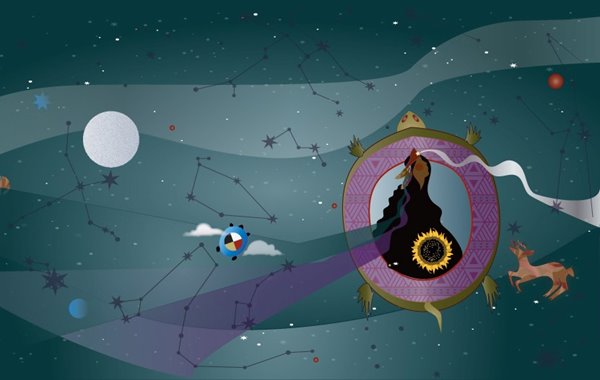Energetic Signatures, LandMarks and Indigenous Art: a conversation with Catherine Tàmmaro
Featured Story
June 2023

Catherine Tàmmaro, Aataentsic: Mother of Stories. Cropped Streetcar/Bus Wrap image, Commissioned in 2023 by the Toronto Transit Commission for Indigenous History Month.
Crawford Lake in Milton, Ontario, is one of 12 locations in the world being considered by scientists as the site which defines the beginning of the Anthropocene Epoch, a proposed new unit of geological time acknowledging humanity’s permanent impact on the planet. Scientists are examining samples of sediment from Crawford Lake and around the world for evidence of nuclear bomb testing that took place in the Pacific Ocean during the 1950s. This ‘bomb spike’ has been selected as the marker that corresponds with The Great Acceleration, the period of unprecedented human disturbance of natural systems that began after World War II that has been selected as the start of the proposed Anthropocene.
Utrihǫt (Faith Keeper) Catherine Tàmmaro, Taǫmęˀšreˀ ~ People of the Little Turtle, Wyandot of Anderdon Nation; Wendat Confederacy, multidisciplinary artist, created a piece entitled “beadSpitter” for her exhibition Fire Over Water, which was first presented at Crawford Lake Conservation Area in 2022. Inspired by the striations of sediment in the varves - the core samples that came out of the lake - Catherine suspended a woven belt representing the oxygen generating organisms' remains trapped in those striations, from the top of an enclosed container into water that she had gathered from the lake. Prompted by Dr. Kathryn Magee Labelle’s book, Daughters of Aataentsic: Life Stories From Seven Generations, and her role as one of eight Wendat and Wyandot Women advisors to the book, the closing exhibition featured original paintings, multi-media works, music and video to honour the Wendat/Wyandot diaspora and the history of the site which extends far back beyond 1950. The exhibition was housed at Crawford Lake for nine months and visited by people from over 62 countries.
For centuries, Crawford Lake has been a gathering place for Indigenous Peoples. Longhouse footprints and Wendat and Attawandaron artefacts were discovered on the site in the seventies, and aural histories have been passed down through time. When creating work for Fire Over Water, a single line from a particular Narrative recorded by Marius Barbeau in Wendake long ago guided Catherine’s work. Only after the exhibition was created, displayed and uninstalled, did Catherine learn of the entire Narrative. “I’m still kind of reeling about this,” noted Catherine about the similarities between the Narrative and “beadSpitter,” which reflects a connection to the sky world, the lake and more.
“The art that I make is held, I believe, within inherited Ancestral memory,” said Catherine. “I've worked hard to almost excise, or allow this work to surface from this place of the unseen, untaught, yet known spaces. I believe in some ways I have awakened to my Ancestral bio-impulses, if you will, and they have largely directed my work over time.”
As someone who has made art for decades not only in Toronto but throughout North America, Catherine’s stories, connections and practices are vast. As an artist and Elder, Catherine is an instigator who provokes others to think anew and challenge the status quo. One such example is an ongoing workshop series that she created and facilitates, centred on Land Acknowledgements. Inspired by one sentence shared by Elder Amy Desjarlais, Catherine began to think of how we can acknowledge the history of the land “in terms of the spiritual or resonant energy that resides here.” Encouraging workshop participants to go out in nature and create whatever awakens in them, Catherine has amassed an archive of poems, sounds, photographs and video recordings of people “connecting to the Natural World in a real way that reflects the understory.”
“I think it's important for people to deconstruct the colonial narrative and ‘restory’ it, privileging Indigenous knowledge rather than settler narratives,” Catherine explains. “Everyone, from all cultures, should have an opportunity to learn how they are also connected to the land and I encourage them to follow their own impulses in the most creative way they can. Everyone has to work together to steward ‘ǫmę́tsa’; the body of the Earth.”
As Toronto Arts Council’s Indigenous Arts Program Manager, Catherine is able to connect with many Indigenous artists, collectives and arts organisations in the city. Nearing the tenth year of the creation of the program, Catherine has noticed a positive shift in its popularity. “It may be challenging for people to get themselves to a space where they feel entitled to apply for arts funding,” noted Catherine. “In my two years at TAC, I’ve noticed that people are applying vigorously. Indigenous arts are flourishing in the city of tǫrǫtǫʔ and I think Toronto Arts Council has done a very good job of being there to support Indigenous artists,” said Catherine.
Catherine is also sure to acknowledge the City of Toronto and city services for increased efforts in supporting Indigenous art. Public art pieces like Catherine’s own 27 bronze plates, which are embedded in Queen Street West on the north side between Spadina and McCaul; her upcoming contributions along with murals by others and more, serve as what Catherine calls “Energetic Signatures, showing that Indigenous people have walked here forever in a deeply connected way.” With the promotion of Indigenous art in the city, Catherine hopes that, “this medicine’ will help people to become aware of the land and give all of us an opportunity to become familiar with Indigenous ontological narratives.”
Some of Catherine’s multidisciplinary works can be accessed on her website.
TAC’s Indigenous Arts Projects program accepts applications throughout the year.